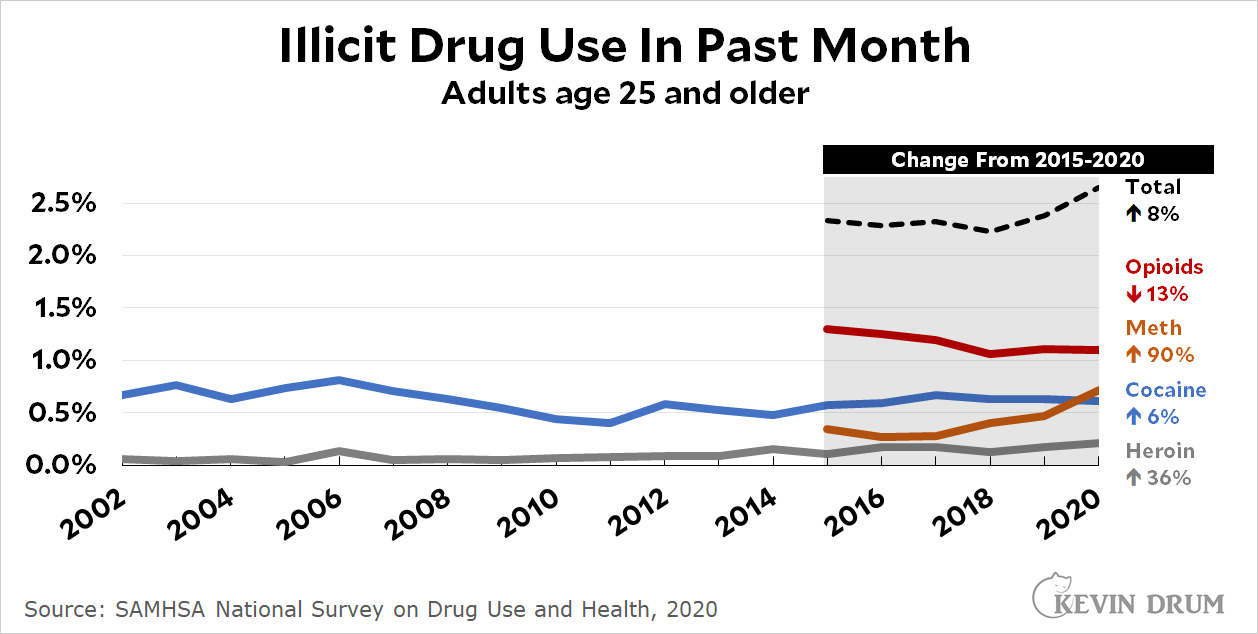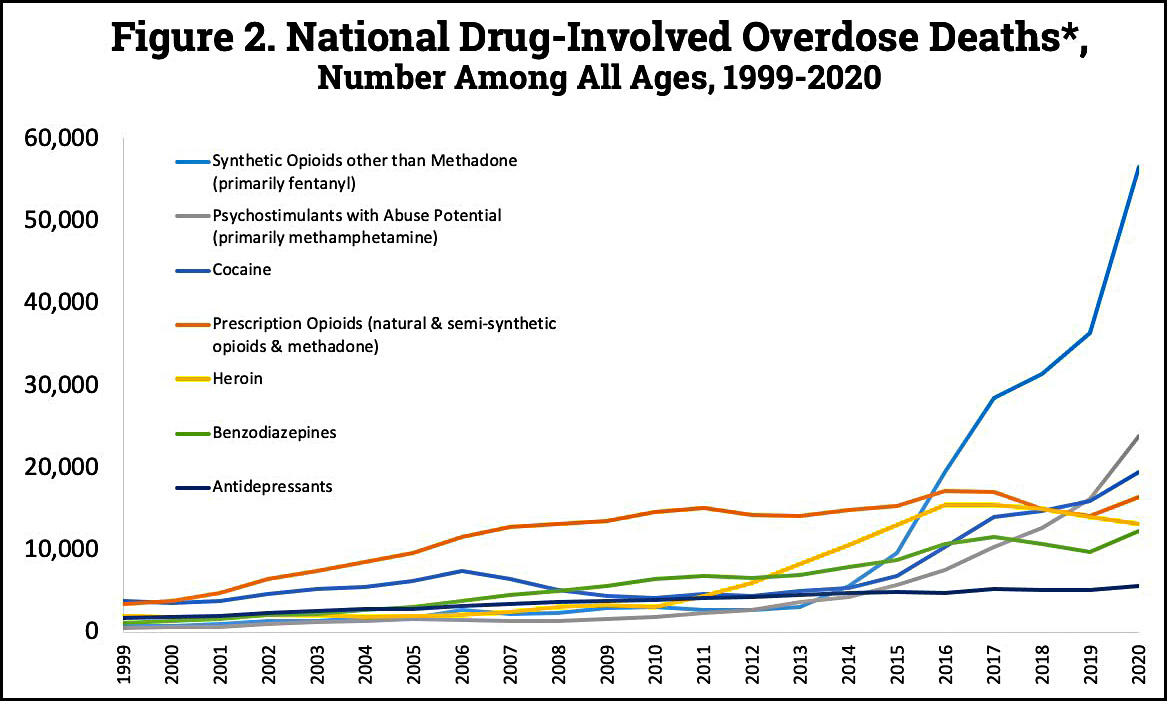Illicit drug use (aside from marijuana) has been steadily falling among teenagers over the past 20 years. But what about adults? Here are the stats from SAMHSA for the four most common drugs:
 Generally speaking, serious drug use has been fairly steady over the past five years, though meth is up a lot. Here are overdose deaths:
Generally speaking, serious drug use has been fairly steady over the past five years, though meth is up a lot. Here are overdose deaths:
 That doesn't look right, does it? Overall overdose deaths are down 12%. Where's the skyrocketing rate of overdose deaths that we all hear so much about?
That doesn't look right, does it? Overall overdose deaths are down 12%. Where's the skyrocketing rate of overdose deaths that we all hear so much about?
It's a trick. The chart above is only for pure versions of the drugs. Here are overdose deaths for the same drugs mixed with synthetic opioids, which mainly means fentanyl:
 This is nearly the whole overdose crisis. Drug use itself is relatively steady, and overdose deaths are down. The problem is with the fraction of drugs that are laced with fentanyl. Here's a NIDA chart showing all overdose deaths:
This is nearly the whole overdose crisis. Drug use itself is relatively steady, and overdose deaths are down. The problem is with the fraction of drugs that are laced with fentanyl. Here's a NIDA chart showing all overdose deaths:
 In 2015 fentanyl accounted for only about 5,000 overdose deaths. Today it's about 55,000. That's not the entire story: meth and cocaine deaths are both up too. But without fentanyl we have only a problem, not a crisis.
In 2015 fentanyl accounted for only about 5,000 overdose deaths. Today it's about 55,000. That's not the entire story: meth and cocaine deaths are both up too. But without fentanyl we have only a problem, not a crisis.
NOTE: The year-to-year data for drug use and overdoses is very noisy. In order to produce reasonable numbers for the change over 2015-2020, I compared the average of 2019-2020 to the average of 2015-2016. That smoothed things out a bit and eliminated a few wild looking outliers.

Correlates with the rise of Trumpism...hmmmmm....
This is an important distinction. I follow a few folks on Twitter who are Chronic Pain Patients, and they're rightfully very upset at how many doctors are now hesitant to prescribe pain meds like opioids. They fear backlash because prescribing opioids is seen to be "contributing to the opioid epidemic". Which, as you illustrate above, is not what's actually happening. Legal prescriptions are staying somewhat steady, but it's the illicit drugs that are causing the most trouble. So these poor folks, who suffer with unimaginable pain, are having their dosages reduced, or in some cases, shunted off to ibuprofen! It's really quite a mess.
This. So much unnecessary suffering.
I agree -- doctors have become overly cautious now with pain management. They're scared shitless a patient will become addicted or something and they'll be held liable. Don't know if that's a possibility or not, but having to live with agonizing post-op pain or cancer pain with just a couple of Tylenol or something is also a very bad outcome.
I've been saying for quite a few years now that the answer is to legalize everything. Street drugs are dangerous mainly because of the complete absence of quality control. If users (not all users, even of heroin, are addicts) could get clinically pure drugs of known strength and dosage the rate of overdose deaths and other severe adverse reactions would plummet.
Fentanyl is a fantastic pain killer. Used in the correct fashion...
Why is Kevin even showing the "trick" graphs at the top? As I read down I was looking for the graph of the totals, which Kevin finally shows at the bottom. Is somebody making an issue out of the "trick" increase percentages?
Fentanyl is certainly the biggest problem and the greatest recent increase, but not the only problem- all the others have been increasing also since 1999 and they add up to a lot as well.
It would help to show the overall total, and maybe the total of non-fentanyl overdose deaths.
Just got around to watching the WaPo/HBO doc "The Crime of the Century" covering Oxy/Fentanyl. Recommended and horribly depressing. Slashing the DEA's ability to go after drug companies went about as badly as expected.
I dunno. This is all very interesting. But what I'd like to know is why, after I've paid for health insurance to the tune of tens-of-thousands of dollars over the years, when I finally need a procedure, I have to pay $1800 out-of-pocket to cover it myself. What did I pay all that money for over the years? I think I know the answer--it's because then health care providers can suck it all dry in one fell swoop, as long as they delay doing their jobs, preferably something that will kill me in the end.
You want to know how and why drug abuse is so high and so trenchant? Look to the industries that make it that way. Health care in America now. It's out to kill you one way or another if there's a profit to be made. Dear Kevin Drum, while you're collecting however much you're getting for the care you've been getting over the past many years from this industry, god help you in the end, you've been blinkered completely when it comes to assessments of this kind. Your charts don't show it.
It's not the drug abuse that's the problem. It's medicine in general, frankly, its origins and its aims. They have nothing to do with health or care. They're all about killing.
Yes, you pay insurance premiums year after year so that they can pay out for that one big expensive event. And such medical events are much more frequent late in life when most people's income is reduced, which means that younger people must pay premiums without getting anything back.
But the high cost of prescription drugs is not due to the inefficient insurance industry, it is due to way that pharmaceutical companies with patents are allowed to charge as much as they want. And as Dean Baker often explains, the system of high rewards from patents tends to lead to drug companies hiding the real effects of some drugs, which was the case with opioids. They were promoted to doctors as non-habit forming, which is far from the case.
Re: younger people must pay premiums without getting anything back.
But younger people do not stay that way. Unless they die young they become older people and run high healthcare bills of their own. So it isn't the sort of injustice it would be if we were charging women or black people higher premiums. It's rather a matter of smoothing out the premiums over a lieftime.
So this boils down to "If only the illicit drugs people were taking weren't also laced with this other illicit drug everything would be
finebetter." ?Inquiring minds want to know.
Fine. Perhaps even touche, perhaps, but in Kevin's own words:
White powder heroin became very cheap after the invasion of Afghanistan, though 1997 was the split line were bags dropped to 40 dollars from 150 in 1994. Supply surged after 2002 making the amount even more profitable giving high quality heroin in large amounts for cheap money.
You'd need to provide evidence and citations, and probably charts for the hard of hearing, regardless of the conclusions they might draw, to prove your statement. But for all the crap you've posted here over the past year or so, this sounds a little more likely true. What do you really know?
Various drugs of abuse have cycled up and down over the years, but I fear Fentanyl is one that is here to stay because it's so potent, cheap, and difficult to interdict. It's not clear to me that more opioids are being abused, but that the ones that are are much more deadly. On the other hand, methamphetamine is a terrible scourge that tends not to kill but creates brain chemistry that is similar to severe mental illness in some and manifests in a multitude of significant medical issues. The costs in terms of quality of life of meth addicts is huge. But getting to the root of this, what is it in our culture that makes drug abuse so alluring? Something's fundamentally wrong.
I believe the answer to "what is it in our culture that makes drug abuse so alluring" is "nothing in particular". People have been altering their states of consciousness for a very long time with alcohol, with magic mushrooms, with cannabis, with coca, and with a variety of other substances. In short, every society in history, and probably in pre-history, had substance abusers.
The wonders of modern chemistry have increased the menu of mind-altering substances, world trade has ensured that those substances are available everywhere, and modern social safety nets mean that people can use enough drugs to completely disable themselves from working without immediately starving to death. It used to be the case that you had to be rich to be able to be an alcoholic or drug addict. That is no longer so. Addiction has been democratized.
I think the drop in opioid and heroin overdoses can be attributed to the availability of Narcan/Naloxone. It doesn't work on fentanyl od's, though. I think we need to look at the number of od's vs. number of deaths from od's prevented by Narcan. That would give you a better picture of the overall drug problem.
Narcan works on fentanyl. Here's the first citation I found.
https://bjatta.bja.ojp.gov/naloxone/does-naloxone-reverse-any-overdose